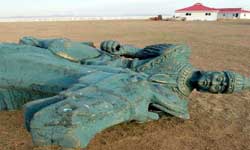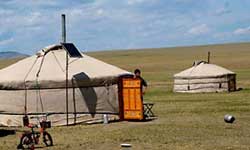 |
On
Mongolia, Buddhism, Exotic Hats
 By
Jamie Hubbard, Yehan Numata Professor of Buddhist Studies By
Jamie Hubbard, Yehan Numata Professor of Buddhist Studies
Mongolia always fascinated me.
Reading about the rise of Chinggis
Khan (known more commonly as Ghengis Khan), from a small,
unknown tribe to founder of the largest empire in the world
boggles my mind. His beloved horses watered from the Korean
peninsula to Moscow, the northern parts of Vietnam, all of
China, Central Asia, Persia, India, and on through Turkey
to the Mediterranean. He could have conquered Europe but
at that point in history, Europe was a useless addition to
his empire. Japan barely escaped conquest when hurricanes
and typhoons destroyed his grandson Kublai Khan’s invasion
fleet.
In order to support his vast
empire, Chinggis Khan and his descendents supported an array
of scholars, scribes, civil servants, merchants, engineers
and scientists. Religious sentiments of all stripes were
tolerated, and huge numbers traveled freely and safely through
this vast area we now call Eurasia. A widely cited cliché of this “Pax
Mongolia” is that a virgin carrying a bag of gold could
ride unmolested from one side of the empire to the other.
Now, 800 years or so later,
my colleague Rick Taupier, Associate Director for International
Research at the University of Massachusetts, Amherst, suggested
that, with the resurgence of Buddhism in post-Soviet Mongolia,
we should hold a conference on this important topic. And
it should take place at Smith, he added, given the strengths
of Buddhist Studies here.
Not realizing what I was getting
into, I agreed, and the conference, Buddhism in Mongolia:
Rebirth and Transformation,
was born. It will take place March 27-29 ().
 Preparing for the conference during the year since has been
a blur of some of the most fun and interesting times I have
ever had. I began by traveling, in this case to St. Petersburg,
Russia. There is a large Mongol population in Russia (such
as in Kalmykia, the only Buddhist state in Europe), and an
old Buddhist temple in St. Petersburg that had been restored
in the years since the fall of the Soviet Union. Considering
my goal of studying the Buddhist revival in post-Soviet Asia,
this seemed a great place to start. Preparing for the conference during the year since has been
a blur of some of the most fun and interesting times I have
ever had. I began by traveling, in this case to St. Petersburg,
Russia. There is a large Mongol population in Russia (such
as in Kalmykia, the only Buddhist state in Europe), and an
old Buddhist temple in St. Petersburg that had been restored
in the years since the fall of the Soviet Union. Considering
my goal of studying the Buddhist revival in post-Soviet Asia,
this seemed a great place to start.
Okay, disclosure: the real reason
for starting in Russia was that I was finally going to fulfill
my long-held dream of taking the Trans Siberian Railway across
Russia, connecting to the Trans Mongolian railway, and making
my way to Mongolia. I love trains and riding in a first-class
sleeper carriage for seven days (about $500) was a lot more
attractive than the flight, which would altogether take about
35 hours cramped into the cattle section with surly flight
attendants. The train—with blue Persian rugs on the
floors, lace doilies on the tabletops, babushka selling dried
fish on the train platform—was everything I hoped and
more. The long, never-changing scenery of the steppes left
little to do other than read, eat, drink, and sleep (occasionally
slumming down to second class and hanging out with the backpacker
world-traveler crowd), so it also was one of the more peaceful
and restful travels I have had—barring a few hilarious
and/or tense moments at various border crossings, but that’s
another story.
And finally: Mongolia. My primary mission was to meet with
the scholars and monks who would be attending and helping
plan our conference. Together we began to structure the event.
One important theme, we agreed,
would be to distinguish between Tibetan and Mongolian Buddhism.
Because the Mongols follow Tibetan Buddhist lineages and
study philosophical texts in Tibetan, the distinctions between
the two are often blurred, something of an insult to Mongolians.
It is often forgotten, for example, that the institution
of the Dalai Lama was a creation of a Mongol Khan in return
for Mongol political and military support. Mongolian Buddhist
visual and performance art is another area of distinctive
Mongolian contribution to Buddhist culture. So one track
of the conference would be historical, following the development
of distinctly Mongolian Buddhism. In this connection we are
also fortunate to be able to host an exhibit of work by Soyolma,
Mongolia’s
2008 Woman Artist of the Year, who will also be in residence
at Smith for three weeks before and after the conference.
 Another theme would be the modern period. Mongolia was the
second Communist nation in the world and during its long
period of Soviet domination Buddhism was destroyed. An estimated
113,000 monks and nearly 1,700 monasteries were entirely
wiped out in a Stalinist purge during the 1930s. The political
role of the monasteries, their resistance to the communism
that threatened their power and role in society, and the
eventual destruction and near disappearance of Buddhism will
be another topic of the conference. Another theme would be the modern period. Mongolia was the
second Communist nation in the world and during its long
period of Soviet domination Buddhism was destroyed. An estimated
113,000 monks and nearly 1,700 monasteries were entirely
wiped out in a Stalinist purge during the 1930s. The political
role of the monasteries, their resistance to the communism
that threatened their power and role in society, and the
eventual destruction and near disappearance of Buddhism will
be another topic of the conference.
Finally, the contemporary period since the fall of the Soviet
Union has seen heroic attempts to revitalize a Buddhist heritage
that has all but faded away. During the long absence of an
organized Buddhist church, most Mongolians have returned
to an even more ancient, animistic or shamanist form of religious
practice, celebrating their life under tengri, the “eternal
blue sky.” Today Mongolia faces what can only be called
globalized religious carpetbagging. Tibetans living in exile
are concerned to rejuvenate their religious lineages and
Mormons and Baptists alike are eager to begin theirs. In
the face of all this are young, urban-dwelling Mongolians,
who are encountering Buddhism for the first time much as
a European or American might, and “converting” to
a form of Buddhism much different than that practiced by
their grandparents.
In some ways Mongolia today
feels a bit like the Wild West of the imagination—new
and fresh, with boundless opportunities for development and
exploitation. What is not imagination, though, is that there
is an excitement and exuberance among the people, a feeling
that the future is indeed as wide open as the eternal blue
sky, and a sense that history is being made.
Through this conference, the first of its kind in the U.S.,
we hope to highlight the Mongol contribution to Buddhist
culture while focusing on the unique challenges and opportunities
present for contemporary Mongolian Buddhists.
The speakers, from Mongolia,
Russia, China, London, Switzerland, Tibet and the U.S., represent
the “A” team of
scholars and monks studying Buddhism in Mongolia. Plans are
already in place to follow this conference with another at
the National University of Mongolia in 2010, and a third
at Emory University in 2011.
And last but not least, the conference will afford me an
opportunity to wear some of the exotic hats I brought back
from Mongolia. But those, like some of the border-crossing
stories, are a subject for another time.
|
 |























